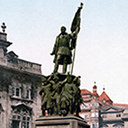0265 Czech Sculpture in the Late 19th and Early 20th Centuries and Its Attitude Towards Vienna
Identifiers (Article)
Abstract
During the course of the 19th century, Czech society underwent an intensive process of national revival and emancipation from Vienna. This, of course, was also projected onto the field of visual arts: For a long time, under the influence of Czech nationalists, surveys of developments in the arts field did not include German-speaking artists from the Czech lands, such as the brothers Max and Franz Metzner or Hugo Lederer. Contacts between both individuals and institutions and Vienna thus became extremely complicated, and after 1900 they were generally considered undesirable by Czech nationalists. In 1902, the Mánes Fine Arts Association, which can take much of the credit for promoting modern art in the Czech milieu at that time, organized an exhibition in Prague of the works of Auguste Rodin, whose artistic style fundamentally influenced Czech sculpture in the first decade of the 20th century and disrupted the monopoly enjoyed until then by Josef Václav Myslbek. In contrast to Myslbek’s conventional equestrian monument to St Wenceslas, two other national monuments in Prague, the statues of Jan Hus (by Ladislav Šaloun) and of František Palacký (by Stanislav Sucharda) reflect the fascination with Rodinesque pathos at that time. The politically motivated suppression of contacts between the Czech milieu and Vienna and German-speaking countries on the one hand, and the support for intensive communication with Paris on the other, contributed to the progressive tendencies in Czech art before the First World War and to its exceptional plurality of styles.
Statistics


License

This work is licensed under a Creative Commons Attribution-NonCommercial-NoDerivatives 4.0 International License.



